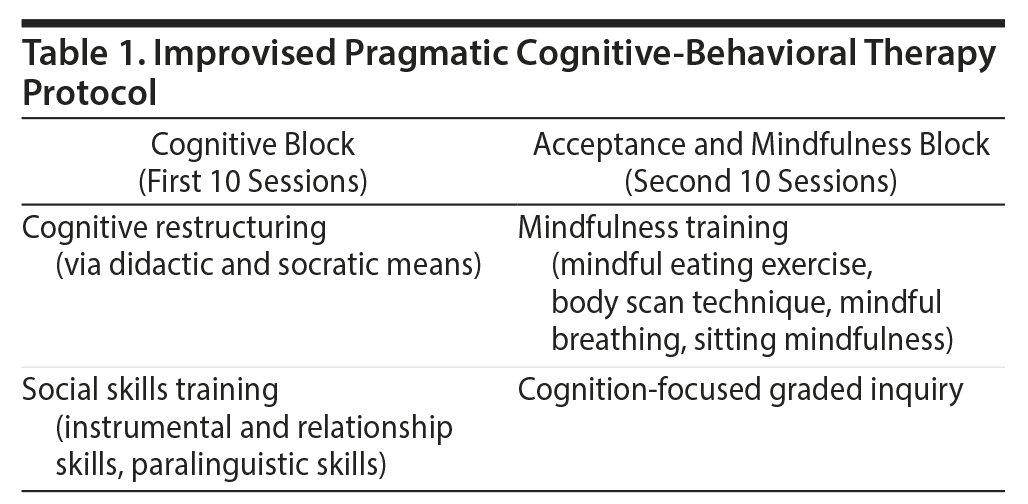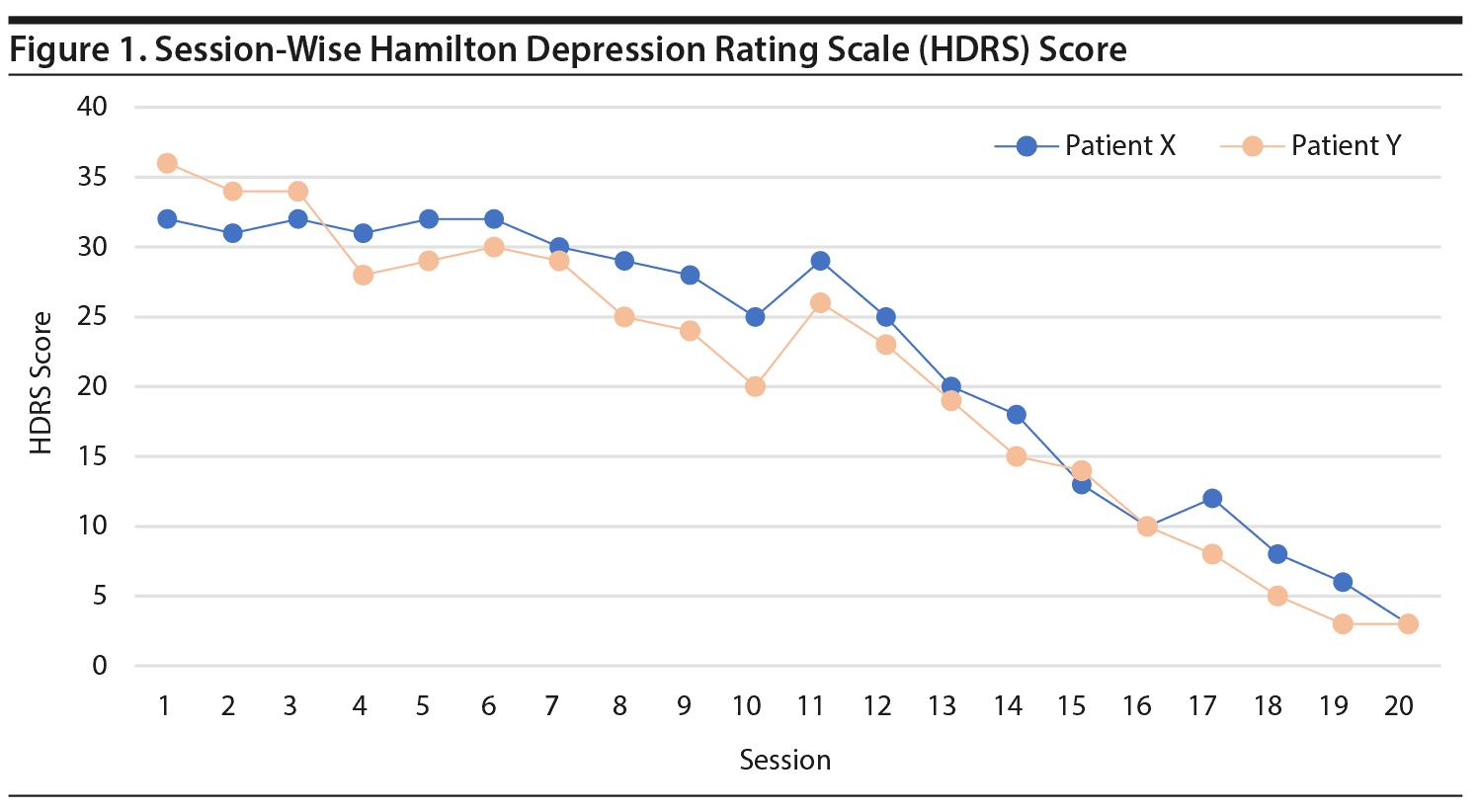
Improvising Pragmatic Cognitive-Behavioral Therapy for Depressed Adolescents With Asperger Syndrome
There is promising evidence to support the usefulness of cognitive-behavioral therapy (CBT) for comorbid depressive and anxiety disorders in people with Asperger syndrome (AS) (ICD-10-DCR). The areas of emphasis in CBT procedures have given rise to the concept of CBT as coming in waves or generations.1 Of these CBT techniques, mindfulness-based therapies and acceptance and commitment therapies (ACTs) are classified under third-wave therapies. Attempts are constantly made to improvise the available techniques in the realm of CBT to the next-generation level for optimum response. Research is increasing into the applicability of third-wave CBT techniques for AS. The application of ACTs specific to AS is fraught with difficulties in the pragmatism area because pragmatism in traditional CBT for AS and ACT has different connotations.2,3 In addition to cognitive restructuring, most studies and texts on CBT for AS describe a therapist’s focus on social skills deficit, social competency, and social problem solving. This specific CBT approach is termed pragmatic CBT, as it addresses the core deficits in AS (ie, impairments in social communication) in an inclusive manner.4 Whereas in ACT, contextualism (the core analytic unit of ACT) is described as pragmatism in functional terms. The wholesome pragmatic truth criterion is applied instead of the mechanistic traditional view. Contextualism shares its platform with traditional CBT by focusing on "here and now" but in a different fashion and at a deeper level wherein the functionality of the phenomenon is more focused.3 The purpose of this report is to elucidate an improvised CBT approach to adolescents with AS presenting with depressive disorder by infusing acceptance and mindfulness techniques into traditional pragmatic CBT.
Case Report
The 2 young men (Mr X and Mr Y) included in this trial were living in the community with their parents and pursuing bachelor of technology degrees at their respective engineering colleges. They were brought to the psychiatric clinic with complaints of low mood, lack of interest in pleasurable events, and suicidal ideations. Clinical interview indicated qualitative abnormalities in reciprocal social interaction (eg, impairments in the use of facial expression while interacting, impairments in social use of eye contact) and unusually intense and circumscribed interests in costly yachts (Mr X) and in evolution of schools (Mr Y). The adolescents’ social deficits were noted by their parents several years prior to the onset of the depressive episode. The history and current symptomatology indicated a developmental disorder qualifying for AS with comorbid depressive disorder based on ICD-10-DCR.
Mr X, aged 17 years, had a 6-month history of depressive episode and AS symptoms since the age of 13 years. He had been treated with escitalopram 20 mg once daily for 4 months with no perceived improvement in depressive symptoms.
Mr Y, aged 18 years, had a 9-month history of depressive episode and AS symptoms since the age of 11 years. He had been treated with desvenlafaxine extended release 50 mg once daily for 8 months and amisulpiride 50 mg twice daily for 4 months with minimal perceived reduction in depressive symptoms.
Instead of titrating the patients’ respective pharmacologic regimen to the optimal level, we suggested to augment the existing regimen with psychotherapy. The parents gave their consent to implement the new CBT procedure for their children. Neither patient had been treated previously with psychotherapeutic procedures. The pretherapy scores for Mr X and Mr Y on the 17-item Hamilton Depression Rating Scale5 (HDRS-17) were 32 and 36, respectively, and on the Social Functioning Questionnaire6 (SFQ) were 16 and 18, respectively. The scales were applied every week at the end of each therapy session.
The therapy protocol consisted of 20 weekly, individual, face-to-face sessions lasting 60 minutes. The therapy package was divided into 2 halves (10 + 10 sessions; Table 1). The first half was designated as the cognitive block, and the second half was designated as the acceptance and mindfulness block. The protocol followed a modular fashion, and the patients received core foundational skills training in problem solving through cognitive restructuring and social skills training. Cognitive conceptualization revealed dysfunctional cognitions in interpersonal and self-image domains. For example, expressions like "Everyone in my class dislikes me," "I am a total failure," and "I can never cope with my classmates" were noted. Cognitive restructuring was attempted through both didactic and socratic means. Each session had a dedicated section addressing social and communicative deficits. Emphasis on social skills training focused on deficits in instrumental and relationship skills via verbal (greeting with handshakes, turn taking, etc), nonverbal (eye contact, posture, etc), and paralinguistic (voice volume, rate of speech, etc) coaching. Habilitation (learning new social skills) was accomplished through role playing within the sessions. The techniques used were attuned to the developmental deficits/characteristics that are inherent with AS, such as slow learning ability (extending session duration), poor abstraction abilities (limited use of metaphors; if needed, simple ones were used), difficulty in discussing emotions through verbal means (using scriptures/depictions), overscrupulous nature (using a pedantic style), and a need for autonomy (involving them in decision-making throughout the course of the therapy).
The last 10 sessions were a period of transition from the information processing level to third-generational therapies. In a sequential way, the acceptance and mindfulness practice was infused into the therapeutic module. Starting from a mindful eating exercise, the successive techniques included body scan technique, mindful breathing, and sitting mindfulness.7,8 A cognition-focused graded inquiry to inner experience, which includes exclusive focus on secondary cognitive evaluations of the primary thought process and the emotional state, was implemented as a major step toward taking the patient to the acceptance mode. During the therapy sessions, the patients learned the suggested therapeutic techniques with ease and implemented the skills effectively. The patients were motivated to select individual skill modules to deal with distressful situations (distress tolerance in an acceptance-oriented way or attaining deeper relaxation in a mindful space, depending on the demand of specific situations). They were encouraged to assimilate and integrate the mindfulness technique in a side-by-side fashion with cognitive and social communication skills. The final HDRS-17 score was 3 for Mr X and 2 for Mr Y (Figure 1). The patients remain free from depressive symptoms during follow-up evaluation (over a period of 2 months), attend college regularly, and perform satisfactorily in academics. Their interpersonal effectiveness also has improved (as noted by SFQ scores of 7 and 9 for Mr X and Mr Y, respectively).
Discussion
Current research and recommendations on mindfulness-based therapies for AS instruct a therapist toward a predominantly meditation-based approach, which involves direct training in breathing meditation, sensory awareness exercise, body scan, and sound meditation.9,10 These preparatory steps toward mindfulness were mostly drawn from mindfulness works by Kabat-Zinn7 and mindfulness-based cognitive therapy for depression by Segal et al.8 Because AS is a developmental disorder, any attempt to extrapolate mindfulness will require a concerted multipronged approach with the infusion of higher-order techniques into a sociocognitive framework rather than a purified mindfulness meditation practice. A few authors11on the mindfulness practice have stated that specific mindfulness techniques were difficult to conceive even for trainers with their expertise. Following the same line of logic, an empathetic appraisal would indicate that it is tough for someone who is experiencing intense depressive agony to shift from destructive ways of thinking to detached mindful ways of thinking, which asks them to see thoughts just as thoughts. The major difference between cognitively oriented and mindfulness-based approaches lies in the illustration of the gap between adaptive cognitive manipulations and experiential handling of emotional states. Cognition-focused graded inquiry, as a technique to focus on direct experience, can act as a supportive scaffolding to a predominantly meditative practice. Before attempting mindfulness-based intervention, a developmentally oriented formulation in the pragmatic cognitive mode is recommended as a prerequisite for the best outcome in adolescents suffering from AS. Therefore, mindfulness methods such as decentering and cognitive defusion need to be used as a part of a holistic CBT program and not as isolated steps.
Potential conflicts of interest: None.
Funding/support: None.
Patient consent: Consent was received from the patients’ parents to publish the case report, and information has been de-identified to protect anonymity.
Published online: June 27, 2019.
REFERENCES
1.Olatunji BO, Hollon SD. Preface: the current status of cognitive behavioral therapy for psychiatric disorders. Psychiatr Clin North Am. 2010;33(3):xiii-xix. PubMed CrossRef
2.Pahnke J, Lundgren T, Hursti T, et al. Outcomes of an acceptance and commitment therapy-based skills training group for students with high-functioning autism spectrum disorder: a quasi-experimental pilot study. Autism. 2014;18(8):953-964. PubMed CrossRef
3.Hayes SC, Luoma JB, Bond FW, et al. Acceptance and commitment therapy: model, processes and outcomes. Behav Res Ther. 2006;44(1):1-25. PubMed CrossRef
4.Gaus VL. Cognitive-Behavioral Therapy for Adult Asperger Syndrome. New York, NY: The Guilford press; 2007.
5.Hamilton M. Development of a rating scale for primary depressive illness. Br J Soc Clin Psychol. 1967;6(4):278-296. PubMed CrossRef
6.Tyrer P, Nur U, Crawford M, et al. The Social Functioning Questionnaire: a rapid and robust measure of perceived functioning. Int J Soc Psychiatry. 2005;51(3):265-275. CrossRef
7.Kabat-Zinn J. Full Catastrophe Living. New York, NY: Bantam Dell, a Division of Random House Inc; 1990.
8.Segal ZV, Williams MG, Teasdale JD. Mindfulness-Based Cognitive Therapy for Depression. New York, NY: The Guilford Press; 2002.
9.Spek AA, van Ham NC, Nykl×Äek I. Mindfulness-based therapy in adults with an autism spectrum disorder: a randomized controlled trial. Res Dev Disabil. 2013;34(1):246-253. PubMed CrossRef
10.de Bruin EI, Blom R, Smit FM, et al. MYmind: Mindfulness training for youngsters with autism spectrum disorders and their parents. Autism. 2015;19(8):906-914. PubMed CrossRef
11.Didonna F. Clinical Handbook of Mindfulness. New York, NY: Springer Science; 2009.
aDepartment of Psychiatry, All India Institute of Medical Sciences, Mangalagiri, Vijayawada, Andhra Pradesh, India
*Corresponding author: Jaiganesh Selvapandiyan, MD, Department of Psychiatry, All India Institute of Medical Sciences, Mangalagiri, Vijayawada, Andhra Pradesh 522503, India ([email protected]).
Prim Care Companion CNS Disord 2019;21(3):18l02381
To cite: Selvapandiyan J. Improvising pragmatic cognitive-behavioral therapy for depressed adolescents with Asperger syndrome. Prim Care Companion CNS Disord. 2019;21(3):18l02381.
To share: https://doi.org/10.4088/PCC.18l02381
© Copyright 2019 Physicians Postgraduate Press, Inc.
Please sign in or purchase this PDF for $40.00.






